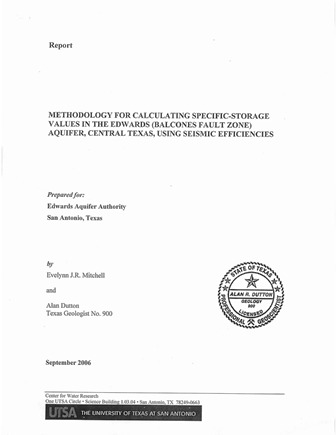Methodology for Calculating Specific-Storage Values in the Edwards (Balcones Fault Zone) Aquifer, Central Texas, Using Seismic Efficiencies

| Author | Mitchell EJR and Dutton A (University of Texas at San Antonio) |
| Year | 2006 |
| Description | Description of a method to estimate storativity of the Edwards Aquifer, Balcones Fault Zone, San Antonio Segment based on seismic efficiency calculations (transient changes in hydrodynamic pressure after seismic events) |
| Publisher | The University of Texas at San Antonio Center for Water Research |
| Location | Edwards Aquifer, Balcones Fault Zone, San Antonio Segment |
| Cover | View Download |
| File | View Download |
| Summary |
|
Specific storage in confined aquifers is usually found from either paired-well field tests or calculated estimates for barometric or tidal efficiency. However, the paired wells required for a drawdown or recovery test are generally sparse in any aquifer, including the Edwards aquifer, so this method does not yield much data. Calculating barometric efficiency requires at least several monthsof detailed records on water levels and atmospheric pressure. Tidal efficiency calculations also require months of water level records as well as access to geodetic data. An additional issue that needs to be addressed is the heterogeneous nature of karst aquifers, where specific storage estimates derived from onewell location maynot represent the aquifer as a whole. Thus a method is needed that can quantify specific storage regionally, without the problems of the previous methods. Seismic efficiency calculations provide an approach for estimating aquifer compressibility. Pressure waves generated by seismic events can cause a rapid water-level response in confined aquifers asthe surface wave passes. The water-level response lasts <1 hour, so detrending is not needed. The Edwards aquifer is a logical choice as a study area for this research because seismic events have been shown to produce sizable signals in several of the wells that are equipped with analog or chart recorders. Also, the Edwards aquifer is a known karst aquifer, and therefore a heterogeneous system, with potentially varying storativity. |
Search for Documents
Advance Search
Explore EAA's Scientific Reports
- All Reports
- Geomorphology and Caves
- Weather Modification
- Geology
- Water Use and Conservation
- Geochemistry
- Water Resources Planning and Management
- Floods and Drought
- Water Quality
- Climatology
- Surface Water / Groundwater Relationship
- Biology
- Springs, Groundwater Discharge
- Archaeology
- RZ Protection
- Aquifer Levels
- Remote Sensing
- Precipitation
- Overview Studies
- Modeling
- Hydrology and Hydrogeology
- History
- Groundwater Recharge, Recharge Zone
- Groundwater Movement
